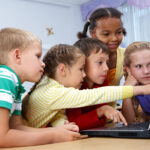You know that expression : if you can’t see it, you can’t be it? I think it’s worth thinking about that in relation to our speech and language therapy clinics and in education settings too. I’ve been reading some studies looking at language learning environments and what features can benefit all children. The research shows that positive multilingual language learning environments include giving emotionally and intellectually supportive and personalised feedback, encouraging children’s autonomy, and open dialogue among teachers, children and their peers. If you want to find out more about the ins and outs of praise, you can read this post and try the three praise challenges here.
So how to make your therapy or classroom more culturally sensitive? Here’s what the research suggests:
- Value children’s home cultures by encouraging them to share their home languages and cultures in classroom activities and help children express their social identities. This depends on your situation and the children too. Some children don’t want to have this attention drawn to them. You’ll know your children best and how to approach this.
- Respect child’s ideas and emotions by allowing the children to co-construct the curriculum by inviting them to contribute information about their interests and inform the design of educational experiences for the classroom. I bet they’ll have some great ideas!
- Foster teacher- parent partnership by involving parents as partners in curriculum design and by connecting families who share cultures and home languages. This helps you build reciprocal relationships with families to further support home language learning.
- Peer partnership in classroom curriculum which involves teachers pairing children at similar language levels to work together. But you need to be sensitive to dynamics between children here too as children may not want to be singled out because of the home language they speak.
Coming next is a post about what do you when you have lots of children speaking lots of different languages in your classroom.
If you like this post, please share it!
Let’s get talking!
MP
What I read so you don’t have to:
Axelrod Y, Cole MW. ‘The pumpkins are coming…vienen las calabazas…that sounds funny’: Translanguaging practices of young emergent bilinguals. Journal of Early Childhood Literacy. 2018;18(1):129-153. doi:10.1177/1468798418754938
De Houwer, A. & Pascall, M. (2021). Our children and their languages: barriers, needs and opportunities: A proposal for early multilingual education KITA Handbook https://www.kindergartenpaedagogik.de/fachartikel/bildungsbereiche-erziehungsfelder/sprache-fremdsprachen-literacy-kommunikation/unsere-kinder-und-ihre-sprachen-huerden-beduerfnisse-und-chancen/
Gort, M., Pontier, R.W. & Sembiante , S. (2012) Function, Type, and Distribution of Teacher Questions in Dual-Language Preschool Read Alouds, Bilingual Research Journal, 35:3, 258-276, DOI: 10.1080/15235882.2012.734262
Gort, M. & Pontier, R.W. (2013). Exploring bilingual pedagogies in dual language preschool classrooms, Language and Education, 27:3, 223-245, DOI: 10.1080/09500782.2012.697468
Khalfaoui, A., García-Carrión, R., & Villardón-Gallego, L, (2021). A Systematic Review of the Literature on Aspects Affecting Positive Classroom Climate in Multicultural Early Childhood Education. Early Childhood Education Journal, 49: 71-81.
Langaloo, A., Lara, M., Deunk, M., Klitzing, N. & Strijbos, JW. (2019). A systematic review of teacher-child interactions with multilingual young children. Review of Educational Research 89(4): 536-568.
Zheng, Z., , Degotardi, S., & Djonov, E. (2021). Supporting multilingual development in early childhood: A scoping review. International Journal of Educational Research 110.

